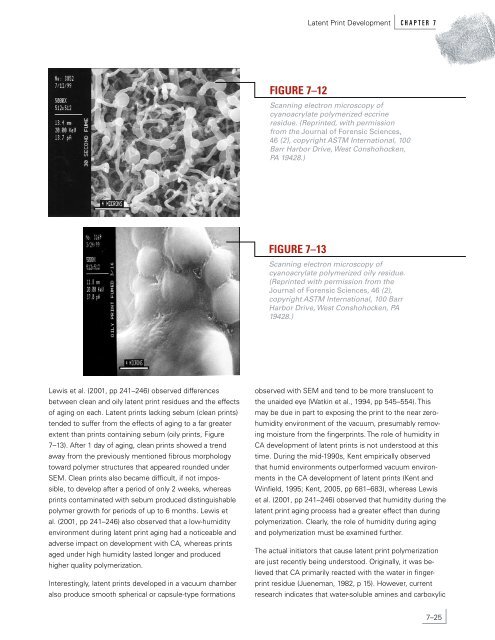Latent Print Development - National Criminal Justice Reference ...
Latent Print Development - National Criminal Justice Reference ...
Latent Print Development - National Criminal Justice Reference ...
You also want an ePaper? Increase the reach of your titles
YUMPU automatically turns print PDFs into web optimized ePapers that Google loves.
Lewis et al. (2001, pp 241–246) observed differences<br />
between clean and oily latent print residues and the effects<br />
of aging on each. <strong>Latent</strong> prints lacking sebum (clean prints)<br />
tended to suffer from the effects of aging to a far greater<br />
extent than prints containing sebum (oily prints, Figure<br />
7–13). After 1 day of aging, clean prints showed a trend<br />
away from the previously mentioned fibrous morphology<br />
toward polymer structures that appeared rounded under<br />
SEM. Clean prints also became difficult, if not impossible,<br />
to develop after a period of only 2 weeks, whereas<br />
prints contaminated with sebum produced distinguishable<br />
polymer growth for periods of up to 6 months. Lewis et<br />
al. (2001, pp 241–246) also observed that a low-humidity<br />
environment during latent print aging had a noticeable and<br />
adverse impact on development with CA, whereas prints<br />
aged under high humidity lasted longer and produced<br />
higher quality polymerization.<br />
Interestingly, latent prints developed in a vacuum chamber<br />
also produce smooth spherical or capsule-type formations<br />
FIGURE 7–12<br />
Scanning electron microscopy of<br />
cyanoacrylate polymerized eccrine<br />
residue. (Reprinted, with permission<br />
from the Journal of Forensic Sciences,<br />
46 (2), copyright ASTM International, 100<br />
Barr Harbor Drive, West Conshohocken,<br />
PA 19428.)<br />
FIGURE 7–13<br />
<strong>Latent</strong> <strong>Print</strong> <strong>Development</strong> C H A P T E R 7<br />
Scanning electron microscopy of<br />
cyanoacrylate polymerized oily residue.<br />
(Reprinted with permission from the<br />
Journal of Forensic Sciences, 46 (2),<br />
copyright ASTM International, 100 Barr<br />
Harbor Drive, West Conshohocken, PA<br />
19428.)<br />
observed with SEM and tend to be more translucent to<br />
the unaided eye (Watkin et al., 1994, pp 545–554). This<br />
may be due in part to exposing the print to the near zerohumidity<br />
environment of the vacuum, presumably removing<br />
moisture from the fingerprints. The role of humidity in<br />
CA development of latent prints is not understood at this<br />
time. During the mid-1990s, Kent empirically observed<br />
that humid environments outperformed vacuum environments<br />
in the CA development of latent prints (Kent and<br />
Winfield, 1995; Kent, 2005, pp 681–683), whereas Lewis<br />
et al. (2001, pp 241–246) observed that humidity during the<br />
latent print aging process had a greater effect than during<br />
polymerization. Clearly, the role of humidity during aging<br />
and polymerization must be examined further.<br />
The actual initiators that cause latent print polymerization<br />
are just recently being understood. Originally, it was believed<br />
that CA primarily reacted with the water in fingerprint<br />
residue (Jueneman, 1982, p 15). However, current<br />
research indicates that water-soluble amines and carboxylic<br />
7–25

















